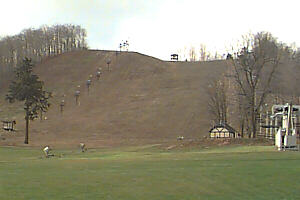Kames are mounds of sediment which are deposited along the front of a slowly melting or stationary glacier / ice sheet. The sediment consists of sands and gravels, and builds up into mounds as the ice melts and more sediment is deposited on top of old debris. Often, a kame will collapse when the ice melts back and leaves the mound unsupported.
Kame Terraces are also composed of sands and gravels, but form along the sides of the glacier rather than at its snout. They are formed by the actions of meltwater streams that flow along the sides of the ice, trapped against it by the valley walls. As the valley walls warm up in summer the warm rock helps to melt the ice nearest to it, forming a long depression or trough along which meltwater flows. Because the deposits in a Kame Terrace have been transported by water, they become sorted, enabling them to be distinguished from lateral morain deposits which exhibit no sorting.
Many of Michigan's major ski hills are on kames.

This material has been compiled for educational use only, and may not be reproduced without permission. One copy may be printed for personal use. Please contact Randall Schaetzl (soils@msu.edu) for more information or permissions.